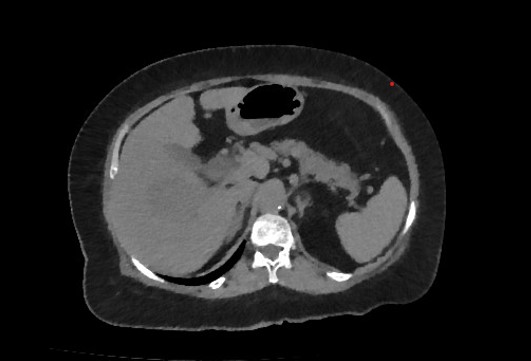Tuesday Poster Session
Category: Liver
Disseminated Hypermucoviscous <i>Klebsiella pneumoniae</i> Infection Presenting as Liver Abscess in a Transplant Recipient
P5967 - Disseminated Hypermucoviscous Klebsiella pneumoniae Infection Presenting as Liver Abscess in a Transplant Recipient
Tuesday, October 28, 2025
10:30 AM - 4:00 PM PDT
Location: Exhibit Hall

Nino Gudushauri, MD (she/her/hers)
Einstein Healthcare Network
Philadelphia, PA
Presenting Author(s)
Nino Gudushauri, MD, Irakli Lemonjava, MD, Maria Lagarde, MD, Robert Fischer, MD
Einstein Healthcare Network, Philadelphia, PA
Introduction: Hypervirulent Klebsiella pneumoniae (HVKP), also known as hypermucoviscous Klebsiella pneumoniae, is an emerging, highly invasive pathogen associated with a distinct clinical entity known as Klebsiella pneumoniae liver abscess syndrome (KLAS) characterized by community-acquired monomicrobial liver abscesses complicated by bacteremia and metastatic spread leading to meningitis, endophthalmitis, and necrotizing fasciitis. It is endemic in East and Southeast Asia. We report a case of KLAS in an immigrant from Cambodia, presenting with liver abscess complicated by endophthalmitis and meningitis.
Case Description/
Methods: A 57-year-old woman originally from Cambodia, with a history of end-stage renal disease status post living donor kidney transplant, type 2 diabetes mellitus, hypertension, and chronic hepatitis B, presented with fever, headache, vomiting, and progressive confusion. On examination, she was febrile to 38.9°C, lethargic, and had right upper quadrant tenderness and a visible hypopyon in the left eye.
Laboratory evaluation revealed leukocytosis (11,800 cells/mm³) and mildly elevated aspartate aminotransferase and alkaline phosphatase levels. Non-contrast abdominal CT demonstrated a 5 cm mass in the periportal region of the right hepatic lobe, consistent with a liver abscess.
Blood cultures grew Klebsiella pneumoniae exhibiting a positive string test, confirming the HVKP, also known as the hypermucoviscous phenotype. Due to worsening mental status, the patient was intubated and started on high-dose intravenous ceftriaxone. Cerebrospinal fluid obtained via lumbar puncture also grew K. pneumoniae, confirming meningitis. Ophthalmologic evaluation confirmed a diagnosis of endophthalmitis.
Discussion: First identified in East Asia, HVKP infections are increasingly reported worldwide, including in non-endemic regions, due to global migration and travel. Often associated with capsular serotypes K1 and K2, contributes to the pathogen's virulence and ability to evade host defenses. Patients with underlying conditions like diabetes mellitus or immunosuppression, as seen in our patient with a history of kidney transplant and diabetes, are particularly susceptible. Early recognition is crucial, as delayed diagnosis can lead to severe complications. This case underscores the importance of considering HVKP in the differential diagnosis of liver abscesses, especially in patients from endemic areas or with relevant risk factors.

Figure: 5 cm mass in the periportal region of the right hepatic lobe, consistent with a liver abscess.
Disclosures:
Nino Gudushauri indicated no relevant financial relationships.
Irakli Lemonjava indicated no relevant financial relationships.
Maria Lagarde indicated no relevant financial relationships.
Robert Fischer indicated no relevant financial relationships.
Nino Gudushauri, MD, Irakli Lemonjava, MD, Maria Lagarde, MD, Robert Fischer, MD. P5967 - Disseminated Hypermucoviscous <i>Klebsiella pneumoniae</i> Infection Presenting as Liver Abscess in a Transplant Recipient, ACG 2025 Annual Scientific Meeting Abstracts. Phoenix, AZ: American College of Gastroenterology.
Einstein Healthcare Network, Philadelphia, PA
Introduction: Hypervirulent Klebsiella pneumoniae (HVKP), also known as hypermucoviscous Klebsiella pneumoniae, is an emerging, highly invasive pathogen associated with a distinct clinical entity known as Klebsiella pneumoniae liver abscess syndrome (KLAS) characterized by community-acquired monomicrobial liver abscesses complicated by bacteremia and metastatic spread leading to meningitis, endophthalmitis, and necrotizing fasciitis. It is endemic in East and Southeast Asia. We report a case of KLAS in an immigrant from Cambodia, presenting with liver abscess complicated by endophthalmitis and meningitis.
Case Description/
Methods: A 57-year-old woman originally from Cambodia, with a history of end-stage renal disease status post living donor kidney transplant, type 2 diabetes mellitus, hypertension, and chronic hepatitis B, presented with fever, headache, vomiting, and progressive confusion. On examination, she was febrile to 38.9°C, lethargic, and had right upper quadrant tenderness and a visible hypopyon in the left eye.
Laboratory evaluation revealed leukocytosis (11,800 cells/mm³) and mildly elevated aspartate aminotransferase and alkaline phosphatase levels. Non-contrast abdominal CT demonstrated a 5 cm mass in the periportal region of the right hepatic lobe, consistent with a liver abscess.
Blood cultures grew Klebsiella pneumoniae exhibiting a positive string test, confirming the HVKP, also known as the hypermucoviscous phenotype. Due to worsening mental status, the patient was intubated and started on high-dose intravenous ceftriaxone. Cerebrospinal fluid obtained via lumbar puncture also grew K. pneumoniae, confirming meningitis. Ophthalmologic evaluation confirmed a diagnosis of endophthalmitis.
Discussion: First identified in East Asia, HVKP infections are increasingly reported worldwide, including in non-endemic regions, due to global migration and travel. Often associated with capsular serotypes K1 and K2, contributes to the pathogen's virulence and ability to evade host defenses. Patients with underlying conditions like diabetes mellitus or immunosuppression, as seen in our patient with a history of kidney transplant and diabetes, are particularly susceptible. Early recognition is crucial, as delayed diagnosis can lead to severe complications. This case underscores the importance of considering HVKP in the differential diagnosis of liver abscesses, especially in patients from endemic areas or with relevant risk factors.

Figure: 5 cm mass in the periportal region of the right hepatic lobe, consistent with a liver abscess.
Disclosures:
Nino Gudushauri indicated no relevant financial relationships.
Irakli Lemonjava indicated no relevant financial relationships.
Maria Lagarde indicated no relevant financial relationships.
Robert Fischer indicated no relevant financial relationships.
Nino Gudushauri, MD, Irakli Lemonjava, MD, Maria Lagarde, MD, Robert Fischer, MD. P5967 - Disseminated Hypermucoviscous <i>Klebsiella pneumoniae</i> Infection Presenting as Liver Abscess in a Transplant Recipient, ACG 2025 Annual Scientific Meeting Abstracts. Phoenix, AZ: American College of Gastroenterology.
